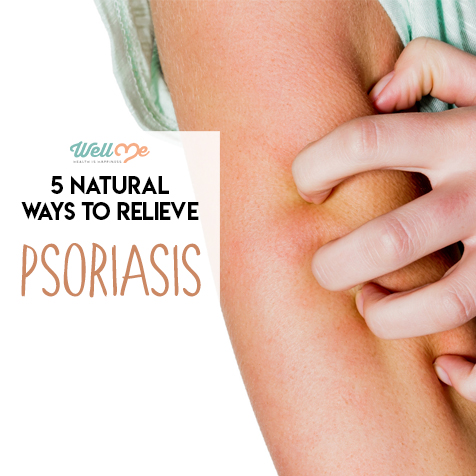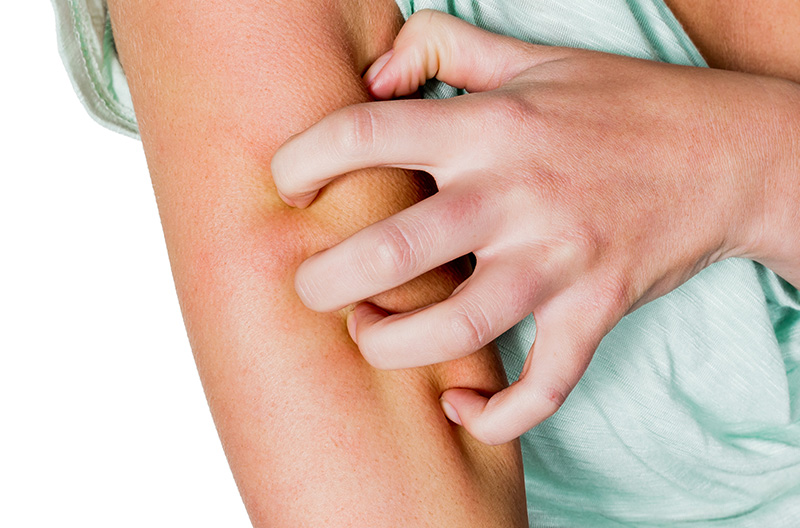Do you ever wonder if you have a health condition that has gone undiagnosed? Are there symptoms that seem to come back time and time again without explanation? You may suffer through them and try to blame them on something else. The symptoms may go away and you think you’re in the clear — and then suddenly they reappear again. This is a very common occurrence with psoriasis, which is often a misunderstood condition that many suffer from.
The most common symptom associated with psoriasis is, of course, the itching and scratching. It may often feel like an uncontrollable condition that you can’t seem to alleviate — it may seem impossible to get a handle on. You can’t quite pinpoint what the problem is, but it’s also very easy to ignore. You may think that it’s a simple skin irritation. You may think it’s a rash. You might think that it’s due to a change in detergent and so you ignore it and move on with your life.
You Suddenly Realize When Something Is Wrong
Then all over again the itching is back and you recognize the symptoms. This time maybe nothing has changed and you can’t imagine that you have a rash again. Is it possible that something else is going on? You might even dismiss it as skin irritation, but you can only do that for so long without breaking down. It is at the point where you simply can’t stand the itching anymore that you decide to get yourself some help.
You have lived with this condition for too long and you want to get some relief from the discomfort the constant itching and scratching is causing you. This may sound like a familiar pattern because there are so many others like you who have been through the exact same situation. When the scratching seems to intensify or when it seems to come about more frequently, you know that something is wrong.
The interesting thing about psoriasis is that it may not necessarily be a direct skin condition at all. Oftentimes when it continues to reappear over and over, it may be something else at play. Let’s learn more about what this condition is and what makes it so very uncomfortable and difficult to live with.
What is Psoriasis?
Psoriasis produces itchy patches of skin and it can make you scratch like crazy. The thing about it, however, is that psoriasis usually derives from something internal or underneath the skin[1]. This is a condition that is usually present for a long time — it may be something that you suffer with for a lifetime and you may not even realize exactly what it is or that it is even present within your body.
Psoriasis isn’t just a rash or a simple skin condition. Many people are surprised to learn that it is actually a disease of the immune system. In mild cases there may be some itching and then that part can go away — this makes it easy to ignore or dismiss. In these instances, you may not even realize that you have a legitimate condition until much later in life, if at all.
Each Case of This Condition May Vary
There are also more severe instances of psoriasis. These are the cases that link psoriasis to something deeper. Psoriasis usually means that the immune system is somehow compromised and that often means that there is another illness present in the body. In the more severe cases, you will often find that psoriasis is linked to something like diabetes, arthritis, or even heart disease. A patient may full well recognize that they have one of the more severe conditions, but have no idea that psoriasis is present even in its more severe state.
The way that psoriasis works is that the immune system is actually overactive – this means that new skin cells are constantly being produced, often much faster than they need to be. These new skin cells may seem like a good thing initially, but they push themselves to the surface quickly and in a fraction of the time than they normally would. Your body can’t shed skin cells as quickly as they appear, so the end result is that the dead skin cells pile on top of each other.
Old skin cells continue to push to the skin’s surface and the result is horrible dry patches that you can see and feel. This regeneration of new skin cells means that dead cells are constantly at the surface, and thus never have a chance to be shed. You will often see these as red, scaly, dry patches of skin – this is the visible side of psoriasis that results in the horribly itchy skin that you simply can’t control.
What Are the Different Types of Psoriasis?
There are five different types of psoriasis[2]. As you can imagine, they run from mild to severe in the way they present and the related symptoms. Understanding what the various types are can help you in determining what you are dealing with.
Though the different types of psoriasis vary in their manifestation and treatment, they have their similarities — read through the list and see if you identify with one type in particular according to your symptoms.
1. Plaque Psoriasis
A milder type of psoriasis, the symptoms, however, are definitely present and visible. This is by far the most common form of the condition and shows itself in the traditional dry red patches of skin. The patches of dry scaly skin can appear all over the body such as on the knees, back, and elbows. Treatment for this type of psoriasis may be as simple as a specific type of moisturizer.
You may find that certain medications help to manage the condition. It’s also important to look into specific triggers you have as that often comes into play. With this type of psoriasis, it may be as simple as learning to avoid or manage your triggers. This is usually a very treatable type of psoriasis that will subside over time.
2. Guttate Psoriasis
This is the second most common type of psoriasis and often very treatable as well. This is a condition that many people have lived with their entire life, and so they learn how to manage it at an early age. This type of psoriasis usually shows itself through smaller red spots that appear on the surface of the skin. This is a type for which triggers such as stress are very common. Even an untreated case of strep throat or another health condition can lead to this type developing.
You will often find these small red spots on the torso or even on limbs in their most common form. If left untreated, the red spots can worsen to a more severe type of psoriasis. You can expect medication to treat and deal with this type of psoriasis, particularly if it derived from an infection such as strep throat. The medication usually does the trick in managing this type of psoriasis.
3. Flexural or Inverse Psoriasis
This is a significantly different type of psoriasis in terms of where it appears on the body. You find flexural psoriasis in the skin folds, and it often develops here after a lot of sweat and moisture develops in this area. These are not red dots, but red and shiny smooth patches of skin. You see this in skin folds typically in the groin or armpit area where you tend to sweat a lot.
The problem with this type of psoriasis is that it is often misdiagnosed for an infection. It may be treated improperly and therefore can come back again. There is help to be found, though you may also want to work to alleviate excess sweating in these common areas as well. You can turn to steroid creams from your doctor. You can also try to treat it as you would a yeast infection, but that’s only on a temporary basis and has limited results.
4. Pustular Psoriasis
This is now where we get into the more severe types of psoriasis. Pustular psoriasis is one of the most severe types and the name derives from pustules which are like white sores encapsulated by red skin around them. These growths can appear nearly anywhere on the body, but are usually in isolated areas and don’t spread quickly. The pustules or scaly growths may come on quickly but then may subside and go into remission.
This is usually a type of psoriasis that you may struggle with for years. There are various subsets or types of pustular psoriasis. The most alarming thing is that you may also experience other symptoms such as fever or chills, loss of appetite, and even muscle weakness associated with this type of psoriasis. This is something to be taken very seriously! Treatment may vary but often includes prescription medication, creams, and even light therapy. It depends upon the frequency, severity, and location of the growths.
5. Psoriatic Arthritis
This may be a bit confusing as it is a type of arthritis but it can affect many who have psoriasis. There are different types and ranges of severity when it comes to psoriatic arthritis. This can be debilitating and it is an actual autoimmune disease whereby the body can wrongfully attack the skin or the joints. It can affect the joints to the point that a person may not be able to move well. The skin symptoms often appear first, but if left untreated, may progress.
The biggest problem and concern surrounding this type of psoriasis is that there’s no known cure or understanding of why this develops. Though this is a bit more rare and painful it is of course serious and must be dealt with early. There are treatments to help alleviate the symptoms such as ibuprofen for the pain and inflammation. There are prescription medications as well which can help with the pain and discomfort. Though you can’t get rid of the condition altogether, things such as medications or even light therapy may at least help to lessen the symptoms or the discomfort that they may cause.
Traditional Treatment Options
Treatment for psoriasis varies significantly based upon the type of psoriasis you have, as well as the way that it is presenting. You may find that using a cream works quite well if you have a mild case. It’s always wise to consult with your doctor, however, no matter what type of psoriasis you are dealing with. They may be able to give you a prescription medication or cream that can provide you with further relief. In some cases, your doctor may look into something like light therapy as a next step in treatment. This has been proven to help with the more severe cases of psoriasis if done frequently.
Causes and Risk Factors
We’ve looked at some potential causes and risk factors, but let’s take it a step further here for clarification. If you have a pre-existing health condition, then that may put you at a greater risk of developing psoriasis. You will often see psoriasis coupled with something like diabetes or even heart disease. It doesn’t mean that one or the other causes each other, but they tend to be present in the body together.
There are other causes or risk factors to be aware of as well. Knowing what these are can help you to work towards prevention or even treatment. You should know that in some cases the actual causes of psoriasis may be unknown. Working to understand potential causes or the factors that may put you at greater risk though is always a good idea. Here are a few common contributing factors.
- Family history: If you have a family history of psoriasis it definitely puts you at greater risk. It doesn’t mean you will necessarily develop the disease for sure, but it can give you a greater likelihood. Be proactive and look for any signs or symptoms of it to be sure that it doesn’t go too far.
- Obesity: If you are significantly overweight, it puts you at a greater risk of developing a wide range of health conditions. Psoriasis is one of these conditions because your immune system is often compromised. Trying to lose weight can be quite helpful in managing your psoriasis or preventing it altogether.
- Smoking: If you are a smoker it can put you at greater risk of developing this condition. What’s worse is that if you already have psoriasis it can make the symptoms and severity more complex. The only surefire way to work towards prevention in this capacity is to quit smoking.
There are great ways to work towards prevention, but in the end it’s all about taking better care of yourself. Even if you already have psoriasis, developing a healthy lifestyle with good habits will help you tremendously. These are just a few of the risk factors, but by exercising, eating right, working towards wellness, and being at an ideal weight you can help to decrease your likelihood of developing it in the future.
Actionable Steps: Natural Ways to Treat Psoriasis
Though there are prescription drugs and medicated creams available, sometimes a natural course of treatment is the best option. Here are some tips for treating psoriasis naturally without drugs:
- Spread aloe vera gel on your skin up to three times a day to reduce redness, scaling, and itching.
- Dilute apple cider vinegar with water in a 1-to-1 ratio and dab it on your skin to relieve itching — this works particularly well for psoriasis on the scalp.
- Try using an over-the-counter or homemade capsaicin cream to dull the pain of severe psoriasis and to reduce redness and scaling.
- Soak in a warm Epsom salt bath for 15 minutes a day to ease itching and remove scales. Towel yourself dry and apply a moisturizer afterward.
- Consume foods rich in turmeric or take a curcumin supplement to reduce inflammation and itching.

Though psoriasis is a very common condition that can be embarrassing to acknowledge or talk about, it is also very treatable. If you’ve been suffering with psoriasis for any length of time, try implementing the steps above to see if they offer you any relief.
References
- [1] “What is Psoriasis?” Psoriasis Speaks. <https://www.psoriasis.com/what-is-psoriasis>
- [2] “Types of Psoriasis.” Healthline. <https://www.healthline.com/health/photos-types-psoriasis#plaque>








